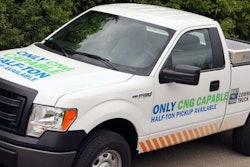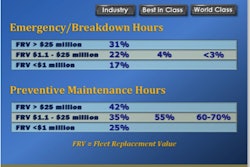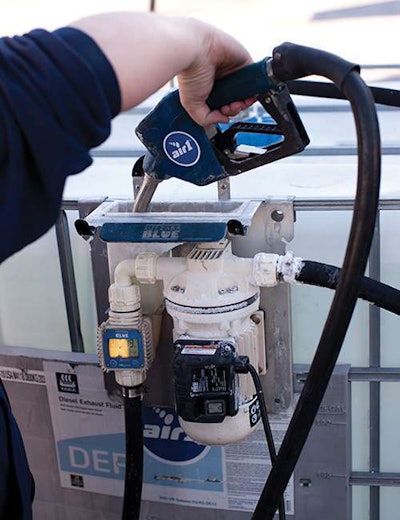
Although the acquisition, storage and handling of DEF adds another layer of complexity to your fleet management practices, the fluid itself is a minor miracle when it comes to reducing exhaust emissions from diesel trucks.
DEF, a liquid mixture of high purity urea and water, is sprayed into the exhaust stream of these engines and when run through a catalyst, the DEF turns the NOx in the exhaust (a major component of smog) into mostly harmless water and nitrogen. This exhaust treatment technology is called selective catalytic reduction, or SCR.
All new heavy highway and diesel pickup truck engines have switched to SCR systems using DEF. It is expected that within the next few years the majority of heavy equipment engines above 74 horsepower will also use it.
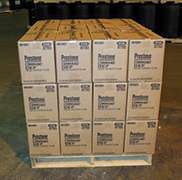 Stock up on small containers of DEF for emergencies and to keep in your trucks.
Stock up on small containers of DEF for emergencies and to keep in your trucks.How is it sold?
DEF is available via pump dispensers at some truck stops that cater to long distance haul trucks. For light truck and automotive use you can buy it in 1- or 2.5-gallon containers. For the heavy equipment shop, however, you’ll likely purchase DEF in 55-gallon drums or 275- and 330-gallon totes.
“The 1-gallon container is primarily for emergency use, in case they run out,” says Thomas Kalagher, product development manager for Prestone Performance Chemicals. It’s something somebody would stash in the cab or toolbox of their truck.
You can already buy the small containers of DEF at retail outlets such as Walmart and auto parts stores. For larger quantities, contact your lube and coolants vendors or an industrial supply source.
As for price, DEF currently trends a little cheaper than diesel fuel. Since diesel engines using SCR technology generally run cooler and achieve better fuel efficiency than those without, the cost washes out in your favor.
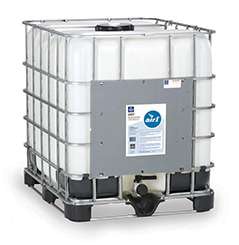 Bulk containers of DEF will be necessary in shops servicing fleets and equipment with advanced emissions engines.
Bulk containers of DEF will be necessary in shops servicing fleets and equipment with advanced emissions engines.How much do you need?
The amount of DEF consumed by your vehicles or equipment will vary depending on the size of truck or engine you’re running, how the engine is configured, and the load you put on it.
The consumption ratio of DEF to diesel fuel is about 2 to 3 percent for on-road, Class 8 vehicles, says Ed Wells, director of sales for the Air 1 division of Yara. Off road machines that use a full SCR system may consume DEF at a rate of 8 to 10 percent of fuel burned, to help control the NOx.
Heavy highway trucks typically have to fill up their DEF reservoir every third tank of diesel. Diesel pickup trucks and vehicles can usually get by with refilling the DEF reservoir every oil change. On heavy equipment, there are too many variables to give a ballpark figure. Load factors and idle time play a big role here.
But it is important to get an estimate and make sure you have enough on hand. If the DEF reservoir on one of your machines or trucks runs dry, the engine will derate or shut down.
“If you’re running a fleet and it’s under 10 vehicles, we recommend the 55-gallon drum and if it’s more than 10 vehicles the 330-gallon totes make a lot more sense,” Kalagher says. “For really big fleets it makes sense to get a couple 330-gallon totes at a time or get a bulk tank for larger purchases.”
As heavy equipment fleets start to develop their DEF management strategies, Kalagher says it’s wise to over-order until you have accurate numbers on what your average DEF consumption rate is. A two to three day delivery time can be expected, he says, but he cautions fleet managers not to let DEF stocks get below one or two week’s worth.
How is DEF dispensed?
Aside from the truck stop pumps, DEF is typically dispensed by a hand pump, an electrically powered or air powered pumps, and even pumps with credit card readers for fleets that consume large quantities and want to keep track of who is using what.
“It’s very important that you use compatible materials in your pumps and dispensing equipment,” says Wells. Fuel pumps are not compatible. A typical generic pump would have aluminum and rubber components, neither of which can be used with DEF. “Fleet managers have to be educated about compatible materials,” Wells says. “A pump with aluminum components will put contamination into the system and has the potential to poison the catalyst. Hoses compatible with petroleum are not compatible with DEF.”
There are a variety of manufacturers who make compatible DEF pumps today. Check out the list in our Resources section at the end of the article.
Precautions when handling
As with any fluid in the shop, you should be careful in handling DEF. But note it’s not a dangerous chemical.
Pumping systems are designed to guard against splash back, Wells says, and mechanics and operators don’t need to wear gloves when dispensing. It’s about as caustic as windshield wiper fluid. If you inadvertently do splash some on your skin or the engine components or machine paint you can simply rinse it off with soap and water. Wells does recommend gloves when working on a DEF pump or tank. Larger spills can be cleaned up with sand, or absorbent materials, but check with your local water authorities about disposal.
There are no big concerns about storage. You want to keep DEF from freezing as it contains a high percentage of water. Otherwise just store it in a cool, dry, well ventilated spot out of direct sunlight. The optimum storage temperature is 77 degrees says Wells, but higher temps won’t affect quality.
Contamination control
Although the DEF spray into the exhaust stream doesn’t affect the engine’s internals, you still need to keep your fluid clean.
“There can be solid contaminants or liquid,” says Kalagher. “If you were to use a funnel for oil and then use it for DEF, you could see some real problems with your catalyst. And that’s the most dangerous thing you can do is contaminate the catalyst.” Replacement costs for these devices may run anywhere from $7,000 to $15,000. That makes it essential to use a clean funnel dedicated to just DEF.
One more point about quality. There are two different certifications to look for. One is the ISO 22241 standard for production. The other is the American Petroleum Institute’s certification. API certification shows you’ve had your product sampled by them and it meets their standards, Kalagher says. Some manufacturers choose not to apply for the API certification because of the cost, he says, and that doesn’t mean the product is tainted or inferior. But you should always look for the ISO certification and never buy DEF that isn’t produced to the ISO standard, he says.
Learning from trucking
The trucking industry has three years of experience dealing with DEF. Wells says the main lesson learned during this time was to partner with a supplier you can count on to deliver a good quality product and one that has the infrastructure to supply the product you need when you need it. “It’s just as important as diesel fuel,” he says. “You have to have DEF to keep your business running.”
The other important element, says Wells, is to educate your drivers, mechanics and operators. “There were a lot of misconceptions initially. A lot of guys were afraid of it.”





